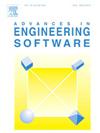On the nonlinear dynamic performance of a novel bistability-driven soft robot
IF 5.7
2区 工程技术
Q2 COMPUTER SCIENCE, INTERDISCIPLINARY APPLICATIONS
引用次数: 0
Abstract
Soft robots have many advantages, including large deformation and excellent motion capability in complex environments. Finding the dynamic behaviour of soft robots is essential for their control and performance optimization. This work has theoretically and experimentally studied the nonlinear dynamic performances of a novel bistability-driven soft robot. The bistable structure consists of a soft spine, an origami shell, and tension springs, which is the critical component to drive the soft robot to move fast, but also generates complex nonlinear dynamic behavior. A nonlinear dynamic model of the soft robot is established based on the piecewise constant curvature method, the generalized coordinate, and Lagrange equations. Extensive experiments have been conducted to investigate the nonlinear dynamic performance of the soft spine, the bistable structure, and the soft robot. Dynamic tests have verified the effectiveness of the theoretical model in terms of the bending angle, velocity, and acceleration changes with time and the deformation morphology at limit states. Results show that the soft robot can switch between two stable states in 0.5 s and rapidly stabilize, enabling rapid movement.
一种新型双稳性驱动软机器人的非线性动态性能研究
软体机器人具有很大的变形量和在复杂环境下的运动能力等优点。研究软机器人的动态行为对其控制和性能优化至关重要。本文从理论上和实验上研究了一种新型双稳性驱动软机器人的非线性动态特性。双稳结构由软脊柱、折纸壳和张力弹簧组成,是驱动柔性机器人快速运动的关键部件,但也会产生复杂的非线性动力学行为。基于分段常曲率法、广义坐标法和拉格朗日方程,建立了软体机器人的非线性动力学模型。对软脊柱、双稳结构和软机器人的非线性动力性能进行了大量的实验研究。动态试验验证了理论模型在弯曲角、速度和加速度随时间变化以及极限状态下变形形态方面的有效性。结果表明,软机器人在0.5 s内可在两种稳定状态之间切换并快速稳定,实现快速运动。
本文章由计算机程序翻译,如有差异,请以英文原文为准。
求助全文
约1分钟内获得全文
求助全文
来源期刊

Advances in Engineering Software
工程技术-计算机:跨学科应用
CiteScore
7.70
自引率
4.20%
发文量
169
审稿时长
37 days
期刊介绍:
The objective of this journal is to communicate recent and projected advances in computer-based engineering techniques. The fields covered include mechanical, aerospace, civil and environmental engineering, with an emphasis on research and development leading to practical problem-solving.
The scope of the journal includes:
• Innovative computational strategies and numerical algorithms for large-scale engineering problems
• Analysis and simulation techniques and systems
• Model and mesh generation
• Control of the accuracy, stability and efficiency of computational process
• Exploitation of new computing environments (eg distributed hetergeneous and collaborative computing)
• Advanced visualization techniques, virtual environments and prototyping
• Applications of AI, knowledge-based systems, computational intelligence, including fuzzy logic, neural networks and evolutionary computations
• Application of object-oriented technology to engineering problems
• Intelligent human computer interfaces
• Design automation, multidisciplinary design and optimization
• CAD, CAE and integrated process and product development systems
• Quality and reliability.
 求助内容:
求助内容: 应助结果提醒方式:
应助结果提醒方式:


